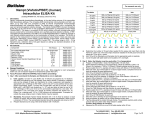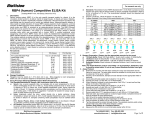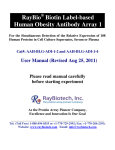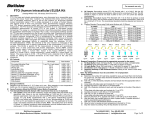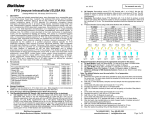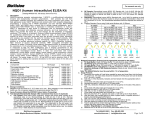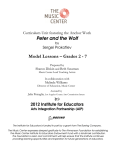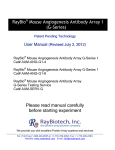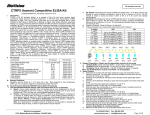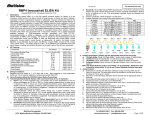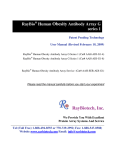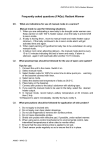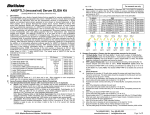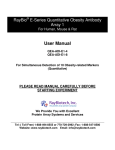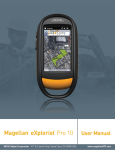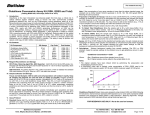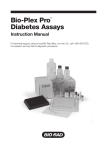Download Nampt (Visfatin/PBEF) (mouse/rat)
Transcript
BioVision Nampt (Visfatin/PBEF) (mouse/rat) Serum ELISA Kit I. II. (Catalog #K4908-100; 100 assays; Store kit at 4°C) Description: Visfatin, an adipocytokine that is highly enriched in the visceral fat of both humans and mice and whose expression level in plasma increases during the development of obesity. Visfatin, a secretory form of Nampt (nicotinamide phosphoribosy-ltransferase), corresponds to pre-B cell colony-enhancing factor (PBEF), a 52 kDa cytokine expressed in lymphocytes. PBEF is an inflammatory cytokine that plays a requisite role in the delayed neutrophil apoptosis of sepsis. Visfatin exerted insulin-mimetic effects in cultured cells and lowered plasma glucose levels in mice. The Nampt (Visfatin/PBEF) (mouse/rat) Serum ELISA Kit is to be used for the in vitro quantitative determination of mouse or rat Nampt (Visfatin/PBEF) in serum. This assay is a sandwich ELISA which utilizies a 96-well microtiter plate which was pre-coated with a monoclonal antibody and a purified polyclonal detection antibody. A HRP-conjugated anti-IgG (Detector) and TMB (3,3’,5,5’-tetramethylbenzidine) is added to generate a color intensity directly proportional to the concentration of Nampt in the samples. This ELISA is specific for the measurement of natural and recombinant mouse and rat Nampt. It does not cross-react with human Nampt, human adiponectin, mouse adiponectin, mouse resistin, mouse vaspin, mouse RBP4, mouse GPX3, mouse progranulin, mouse IL-33, mouse clusterin, mouse ANGPTL3, mouse ANGPTL4, mouse ANGPTL6, mouse leptin, mouse TNF-α. The assay range is 0.5 – 32 ng Nampt/ml and a detection limit of 50 pg/ml (based on adding two standard deviations to the mean value of the zero standard). Kit Contents: Component Pre-coated Microtiter Plate Wash Buffer (10X) Diluent (10X) Detection Antibody Detector (100X) Mouse Nampt Standard (lyophilized,64 ng) TMB Stop Solution Plate Sealers III. V. For research use only rev. 10/15 100 Assays 6 x 16 well strips 2x30 ml 2x30 ml 50 μl 150 μl 1 vial 12 ml 12 ml 2 K4908-100-1 K4908-100-2 K4908-100-3 K4908-100-4 K4908-100-5 K4908-100-6 K4908-100-7 K4908-100-8 K4908-100-9 1. Day 1: (We recommend the Samples and Standards be run in duplicate) a) Serum: Use a serum separator tube. Let samples clot at room temperature for 30 min before centrifugation for 20 min at 1000 x g. Assay freshly prepared serum or store serum in aliquots at -20°C for future use. Avoid repeated freeze/thaw cycles. Serum should be diluted in Diluent 1X. Samples containing visible precipitates must be clarified before use. If samples fall outside the assay range a lower or higher dilution may be required.Allow all samples and kit components to equilibrate to room temperature (20 - 25°C). b) Standards: Reconstitute Mouse Nampt Standard with 1 ml of dH2O to produce a stock solution (64 ng/ml). Mix the Stock solution to ensure complete reconstitution. Allow to sit for a minimum of 15 min. The reconstituted standard should be aliquoted and stored at -20°C. c) Prepare 1X Diluent: Dilute 10X Diluent 1:9 with dH2O. d) Prepare Standard Curve using 2-fold serial dilutions with 1X Diluent: 16 ng/ml Add 300 μl of Nampt (64 ng/ml) 300 μl of Nampt (32 ng/ml) Into 300 μl of 1X Diluent 300 μl of 1X Diluent 8 ng/ml 300 μl of Nampt (16 ng/ml) 300 μl of 1X Diluent 4 ng/ml 300 μl of Nampt (8 ng/ml) 300 μl of 1X Diluent 2 ng/ml 300 μl of Nampt (4 ng/ml) 300 μl of 1X Diluent 1 ng/ml 300 μl of Nampt (2 ng/ml) 300 μl of 1X Diluent 0.5 ng/ml 300 μl of Nampt (1 ng/ml) 300 μl of 1X Diluent 0 ng/ml 300 μl of 1X Diluent Empty tube 64 ng/ml e) Part Number Storage Conditions: Reagents must be stored at 2 - 8°C when not in use. Bring reagents to room temperature before use. Do not expose reagents to temperatures greater than 25°C. Assay Procedure (Read the ENTIRE protocol before proceeding) BioVision Incorporated 155 S. Milpitas Boulevard, Milpitas, CA 95035 USA To obtain 32 ng/ml f) g) 32 ng/ml 16 8 4 ng/ml ng/ml ng/ml 2 ng/ml 1 ng/ml 0.5 ng/ml 0 ng/ml Determine the number of 16-well strips needed for assay and insert them into the frame for current use. The extra strips should be resealed in the foil pouch and can be stored at 4°C for up to 1 month. Add 100 μl of the Standards and Samples into the appropriate wells in duplicate. Cover the plate with plate sealer and incubate at 4°C overnight. 2. Day 2: a) Prepare 1X Wash Buffer: Dilute 10X Wash Buffer 1:9 with dH2O. b) Warm Detection Antibody to room temperature. Dilute the antibody 1:250 in 1X Diluent (8 µl antibody + 1992 µl 1X Diluent). Diluted antibody cannot be stored. c) Remove plate from 4°C, aspirate and wash x 3 with 300 μl of 1X Wash Buffer. d) After last wash, tap inverted plate on a stack of paper towels. Complete removal of liquid is essential for good performance. e) Add 100 μl of Detection Antibody to each well. f) Cover plate with plate sealer and incubate for 1 hr at 37°C. g) After about 30-45 min prepare 1X Detector: Dilute 100X Detector 1:99 with 1X Diluent (100 µl Detector + 9.9 ml of 1X Diluent). h) Remove plate from 37°C, aspirate and wash 3 times with 300 μl of 1X Wash Buffer. i) After last wash, tap inverted plate on a stack of paper towels. Complete removal of liquid is essential for good performance. j) Add 100 μl of 1X Detector to each well. k) Cover plate with plate sealer and incubate for 1 hr at 37°C. l) Warm the TMB Solution and Stop Solution to room temperature. m) Remove plate from 37°C, aspirate and wash 5 times with 300 μl of 1X Wash Buffer. n) After last wash, tap inverted plate on a stack of paper towels. Complete removal of liquid is essential for good performance. o) Add 100 μl of TMB to each well. p) Allow the color to develop at room temperature in the dark for 10 min. q) Stop the reaction by adding 100 μl of Stop Solution to each well. r) Tap the plate gently to ensure thorough mixing. The substrate reaction yields a blue solution that turns yellow when Stop Solution is added. Caution: Stop Solution is a Corrosive Solution s) Measure the OD at 450 nm in an ELISA plate reader within 30 min. Tel: 408-493-1800 | Fax: 408-493-1801 www.biovision.com | [email protected] Page 1 of 2 BioVision 3. Calculations: a) Average the duplicate readings for each standard and Test Sample. b) Subtract the average 0 ng/ml standard from each of the above. c) Generate a Standard Curve by plotting the average absorbances on the horizontal (X) axis vs. the corresponding concentration (ng/ml) on the vertical (Y) axis. (See Typical Data below) d) Calculate the Test Sample Nampt concentrations by interpolation of the Standard Curve regression curve as shown above in the form of a quadratic equation. e) If the Test Samples were diluted, multiply the interpolated values by the dilution factor to calculate the corrected mouse or rat Nampt serum concentrations. For research use only rev. 10/15 Technical Hints and Limitations: It is recommended that all standards and samples be run in duplicate. Do not combine leftover reagents with those reserved for additional wells. Reagents from the kit with a volume less than 100 µl should be centrifuged. Residual wash liquid should be drained from the wells after last wash by tapping the plate on absorbent paper. Crystals could appear in the 10X solution due to high salt concentration in the stock solutions. Crystals are readily dissolved at room temperature or at 37°C before dilution of the buffer solutions. Once reagents have been added to the 16-well strips, DO NOT let the strips DRY at any time during the assay. Keep TMB Substrate Solution protected from light. The Stop Solution consists of Sulfuric acid. Although diluted, the Stop Solution should be handled with gloves, eye protection and protective clothing. Troubleshooting: PROBLEM Performance Characteristics: 1. Intra-assay Precision: (6) samples of known concentration were assayed in replicates (5) times to test precision within an assay. Samples Mean (ng/ml) SD CV (%) n Mouse 1 5.66 0.30 5.30 5 Mouse 2 16.70 1.04 6.21 5 Mouse 3 9.65 0.43 4.44 5 Rat 1 13.59 0.06 0.41 5 Rat 2 10.61 0.17 1.64 5 Rat 3 19.75 0.36 1.84 5 2. Inter-assay Precision: (6) samples of known concentration were assayed in (6) separate assays to test precision between assays. Samples Mean (ng/ml) SD CV (%) n Mouse 1 8.20 0.72 8.80 6 Mouse 2 7.93 0.75 9.44 6 Mouse 3 12.62 0.84 6.68 6 Rat 1 10.75 0.29 2.69 6 Rat 2 19.39 0.91 4.71 6 Rat 3 8.99 0.44 4.87 6 3. Recovery: Mouse and rat serum samples were spiked with known concentrations of mouse and rat Nampt. The recovery averages were 101 % (range from 90 % to 105 % Samples Average Recovery (%) Range (%) Mouse 1 100.70 95 - 105 Mouse 2 99.45 90- 100 Rat 1 100.70 95 - 105 Rat 2 104.65 95 - 105 4. Expected Values: Nampt levels range in mouse or rat samples from 2 to > 30 ng/ml. BioVision Incorporated 155 S. Milpitas Boulevard, Milpitas, CA 95035 USA POSSIBLE CAUSES No signal or weak signal SOLUTIONS Omission of key reagent Check that all reagents have been added in the correct order. Washes too stringent Use an automated plate washer if possible. Incubation times inadequate Incubation times should be followed as indicated in the manual. Plate reader settings not optimal Verify the wavelength and filter setting in the plate reader. Incorrect assay temperature Concentration of detector too high High background Inadequate washing Wells not completely aspirated Poor standard curve Reagents poorly mixed Omission of reagents Unexpected results Dilution error Use recommended incubation temperature. Bring substrates to room temperature before use. Use recommended dilution factor. Ensure all wells are filling wash buffer and are aspirated completely. Completely aspirate wells between steps. Be sure that reagents are thoroughly mixed. Be sure that reagents were prepared correctly and added in the correct order. Check pipetting technique and double-check calculations. FOR RESEARCH USE ONLY! Not to be used on humans. Tel: 408-493-1800 | Fax: 408-493-1801 www.biovision.com | [email protected] Page 2 of 2


